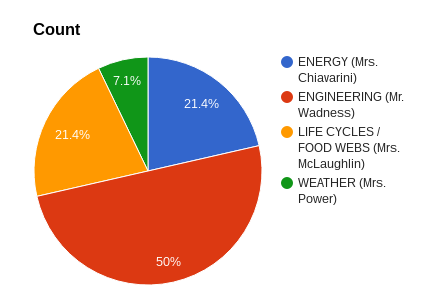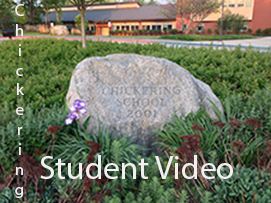In 5th grade there are 5 classroom teachers. They all teach one science unit to all 5th grade students. Every seven weeks, students begin a different science unit in the following topics: Energy; Earth and Space; Life Science: Adaptations, Food Webs, Genetics; Meteorology; and Engineering. We were curious to know if the teachers and the students had the same favorite activity within the science units.
We interviewed each of the 5th grade teachers and asked them to explain their science unit.
ENERGY: In energy, kids continue what they learned in 4th grade. They learn about potential and kinetic energy and review magnets. The students also make circuits, light lightbulbs, test conductors and insulators.
ENGINEERING: In engineering the first project is to make a table made of newspaper, which has to hold lots of books. Introduces Newton’s 3 laws of motion. 2nd project is to make a balloon powered car; the one that goes the furthest wins. Other engineering tasks are to make a catapult and a pasta tower.
LIFE CYCLES: In life science students learn about animals, insects and their biomes, food chains and predator/prey.
SPACE:In Earth and Space science students learn about phases of the Moon, our solar system and earth relationship and the forces of the Earth, how it rotates and spines around the Sun.
WEATHER: In weather, students learn the difference between the climate and weather, weather forecasting, storms and how to stay safe, and water cycle and how it works and causes weather.
Did the teachers have a favorite activity? Mrs. Chiavarini teaches Energy and her students can experiment and try out new ideas. Her favorite activity is the final project where students draw and design a Rube Goldberg machine incorporating different types of energy.
Mr. Wadness teaches Engineering and his favorite activity is to teach about the 3 Laws of Physics by Isaac Newton. These laws state:
1. Every object in a state of uniform motion tends to remain in that state of motion unless an external force is applied to it.
2. The relationship between an object’s mass m, its acceleration a, and the applied force F is F = ma. Acceleration and force are vectors (as indicated by their symbols being displayed in slant bold font); in this law the direction of the force vector is the same as the direction of the acceleration vector.
3. For every action there is an equal and opposite reaction.
He likes to see how the students use one or more of these laws in their problem solving for their project.
Mrs. McLaughlin, who teaches Life Science, explained her favorite activities are owl pellet dissection lab which demonstrates the special adaptations of an owl. As well as, their final project to show animal adaptations and themselves.
Mr. Keohane teaches Earth and Space Science. In his unit, he enjoys when they go outside and create a scale model of the Solar System with his classes.
Weather is taught by Mrs. Power, who loves when the students create a visual or act out the water cycles. She likes seeing the students’ understanding of the water cycle when the water falls on the ground or in the ocean or lake.
The following chart shows the results of Survey I conducted in January, displaying the 5th grade students’ s favorite science unit. In January, students have only rotated through three of the five units.


The chart, below, shows the results of Survey II showing students’ favorite science unit. The major difference between the two charts is this one has no Energy selected and includes Space data. At this point, students are in the middle of their 5th science unit.

We wondered what the students’ favorite activity, within their preferred science unit. The first time we did a student survey was in January; students’ had only completed 3 of 5 science units. The second time we did the survey was March; all students were in their 5th science unit. We were surprised by how much the data had changed.
In both surveys, there was one response for Weather and the activity was “making the snow because it was very fun.” Engineering received 50% in January and 42.9% in March, clearly this is the most popular. One student commented, “The reason I like this unit is because we get to do lots of hands on types of projects and no work sheets yet,” They really liked making catapults, balloon cars and newspaper tables.
Life science, stayed the same in both surveys, receiving 21.4%. One of the respondents said, “I enjoyed presenting our posters, we got to learn about a few individual animals than just some adaptations in general. Another thing I enjoyed about that science unit was when Mrs. Mclaughlin plays the Mr. Parr songs, my favorite was the one about adaptations, his songs are so catchy and make you want to sing along, I still listen to some of them today! So Mrs. Mclaughlin’s unit was my favorite.”
In the 1st survey, Space was not chosen as a favorite science unit, though in the 2nd survey it received a quarter of the votes! Energy acquired 21.4% in the first survey and did not obtain any votes in the second survey. We are not sure why there was such a big change for space and science units, it would take further investigation. Clearly the science units that had a lot of hands-on activities were the favorite!
Reported by Luke B. and Felix
 Chickering Student Radio
Chickering Student Radio




